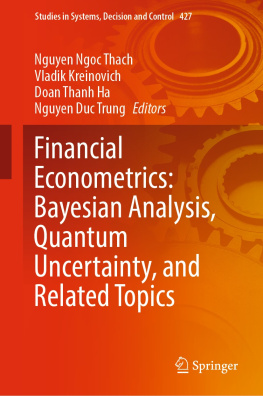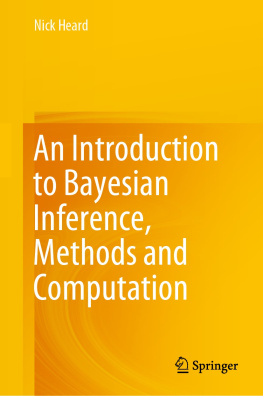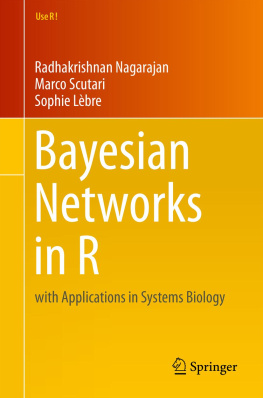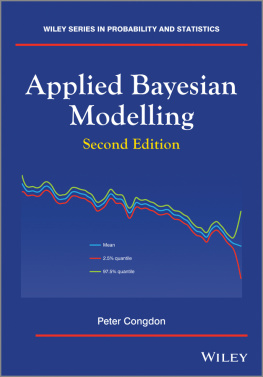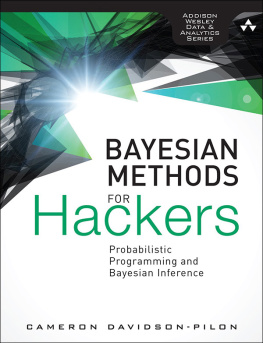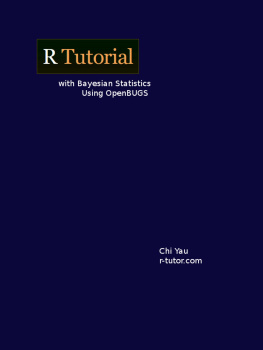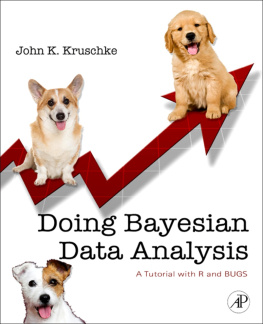The Oxford Handbook of Applied Bayesian Analysis
The Oxford Handbook of Applied Bayesian Analysis
Edited by
Anthony OHagan
Mike West


Great Clarendon Street, Oxford OX2 6DP
Oxford University Press is a department of the University of Oxford.
It furthers the Universitys objective of excellence in research, scholarship,
and education by publishing worldwide in
Oxford New York
Auckland Cape Town Dar es Salaam Hong Kong Karachi
Kuala Lumpur Madrid Melbourne Mexico City Nairobi
New Delhi Shanghai Taipei Toronto
With offices in
Argentina Austria Brazil Chile Czech Republic France Greece
Guatemala Hungary Italy Japan Poland Portugal Singapore
South Korea Switzerland Thailand Turkey Ukraine Vietnam
Oxford is a registered trademark of Oxford University Press
in the UK and in certain other countries
Published in the United States
by Oxford University Press Inc., New York
Oxford University Press 2010
The moral rights of the authors have been asserted
Database right Oxford University Press (maker)
First published 2010
All rights reserved. No part of this publication may be reproduced,
stored in a retrieval system, or transmitted, in any form or by any means,
without the prior permission in writing of Oxford University Press,
or as expressly permitted by law, or under terms agreed with the appropriate
reprographics rights organization. Enquiries concerning reproduction
outside the scope of the above should be sent to the Rights Department,
Oxford University Press, at the address above
You must not circulate this book in any other binding or cover
and you must impose the same condition on any acquirer
British Library Cataloguing in Publication Data
Data available
Library of Congress Cataloging in Publication Data
Data available
Typeset by SPI Publisher Services, Pondicherry, India
Printed in Great Britain
on acid-free paper by
CPI Antony Rowe, Chippenham, Wiltshire
ISBN 9780199548903
13579 10 8642
Preface
A Bayesian 21st century
The diversity of applications of modern Bayesian analysis at the start of the 21st century is simply enormous. From basic biology to frontier information technology, the applications of highly structured stochastic models of increasing realism often with high-dimensional parameters and latent variables, multiple layers of hierarchically structured random effects, and nonparametric components are increasingly routine. Much of the impetus behind this growth and success of applied Bayesian methods over the last 20 years has come from access to the increasingly rich array of advanced computational strategies for Bayesian analysis; this has led to increasing adoption of Bayesian methods from heavily practical and pragmatic perspectives.
Coupled with this evolution in the nature of applied statistical work to a model-based, computational perspective is change in statistical scientific thought at a more fundamental level. As researchers become increasing involved in more complex stochastic model building enabled by advanced Bayesian computational methods, they also become more and more exposed to the inherent logic and directness of Bayesian model building. Scientifically relevant, highly structured stochastic models are often simply naturally developed from Bayesian formalisms and have overt Bayesian components. Hierarchical models with layers of random effects, random processes in temporal or spatial systems, and large-scale latent variables models of many flavours are just a few generic examples of nowadays standard stochastic structures in wide application, and that are all inherently Bayesian models. Much of the rapid growth in adoption of Bayesian methods from pragmatic viewpoints is engendering deeper, foundational change in scientific philosophy towards a more holistically Bayesian perspective. And this, in turn, has important implications for the core of the discipline; bringing Bayesian methods of stochastic modelling centre-stage with models of increasing complexity and structure for reasons of increased realism is inevitably re-energizing the core of the discipline, presenting new conceptual and theoretical challenges to Bayesian researchers as applied problems scale in dimension and complexity.
The Handbook
The Handbook of Applied Bayesian Analysis is a showcase of contemporary Bayesian analysis in important and challenging applied problems, bringing together chapters contributed by leading researchers and practitioners in interdisciplinary Bayesian analysis. Each chapter presents authoritative discussions of currently topical application areas together with key aspects of Bayesian analysis in these areas, and takes the reader to the cutting edge of research in that topic. Importantly, each chapter is built around the application, and represents personal interests, experiences and views of the authors speaking from deep and detailed expertise and engagement in the applied problem area.
Each chapter of the Handbook involves a concise review of the application area, describes the problem contexts and goals, discusses aspects of the data and overall statistical issues, and develops detailed analysis with relevant Bayesian models and methods. Discussion generally contacts current frontiers of research in each application, with authors presenting their own perspectives, their own latest thinking, and highlighting their own research in both the application and in related and relevant Bayesian methodology used in their application. Each chapter also includes references linking to core publications in the applied field as well as relevant models and computational methods, and some also provide access to data, software and additional material related to the study of the chapter.
Importantly, each chapter contains appendix material that adds further foundational and supporting discussion of two flavours: material on the basic statistical models and methods, with background and key references, for readers interested in going further into methodological aspects, and more traditional appendix material representing additional technical developments in the specific application. Collectively, the appendices are an important component and distinctive feature of the Handbook, as they reflect a broad selection of models and computational tools used widely in applied Bayesian analysis across the diverse range of applied contexts represented.
Chapter outlines
Chapters are grouped by broad field of application, namely
Biomedical and Health Sciences
Industry, Economics and Finance
Environment and Ecology
Policy, Political and Social Sciences
Natural and Engineering Sciences
Inevitably selective in terms of broad fields as well as specific application contexts within each broad area, the chapters nevertheless represent topical, challenging and statistically illuminating studies in each case. Chapters within each area are as follows.
Biomedical and Health Sciences
Dunson discusses an epidemiological study involving pregnancy outcomes. This chapter showcases Bayesian analysis in epidemiological studies that collect continuous health outcomes data, and in which the scientific and clinical interest typically focuses on the relationships between exposures and risks of an abnormal response, corresponding to an observation in the tails of the distribution. As there is minimal interest in relationships between exposures and the centre of the response distribution in such studies, traditional regression models are inadequate. For this reason, epidemiologists typically categorize both the outcome and the predictors, with the resulting inferences very sensitive to this categorization. Bayesian analysis using density regression, mixtures and nonparametric models, as developed and applied in this pregnancy outcome study, avoid and overcome these challenges.
Next page

